It wasn’t all that long ago that I supported siloed, ad hoc status updates without any form of measurement, ranging from emails about breakfast in the breakroom to optional training opportunities and event invitations, to fire drill training notifications.
For many businesses, pushing status updates like these was once the norm. With the acceleration of workplace change, however, leaders are increasingly relying on internal communicators to support business goals and organizational outcomes through an employee communication strategy.
The challenge often lies in proving the impact internal communicators have on influencing the communication and action associated with business goals. In this guide, we’ll teach you how to tie internal campaigns to organizational success with an easy-to-follow framework and tools to support your work effectively.
Take a self-guided tour of ContactMonkey
See how our key features can streamline your internal communications.
Take product tour
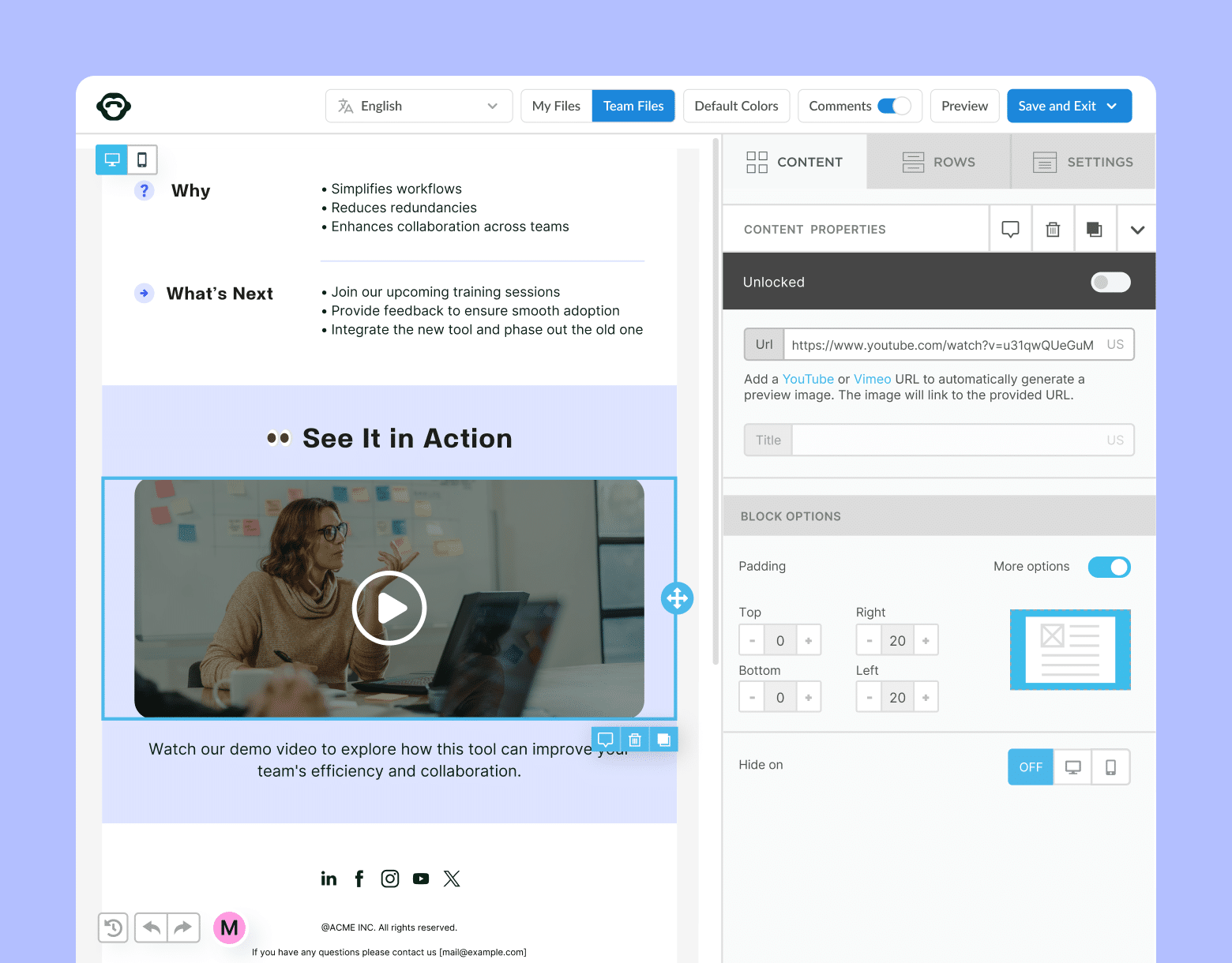
Why Tie Internal Email Campaigns to Business Goals?
On the surface, tying internal email campaigns directly to business goals is a boon for every organization (more opportunities to reinforce and drive progress toward these objectives). But there are several notable benefits for internal communicators and their teams, including:
Building leadership trust with measurable ROI
It’s not always easy to prove the value of the internal communications function, especially when executives want to see data to validate that communication is achieving the intended goals. When internal email campaigns directly support business goals, such as employee retention, change adoption, or event participation, it’s easier to connect communication outcomes to measurable results.
For example, suppose leadership wants to implement a new software system that requires employees to modify their behavior to achieve an improved business efficiency goal. You run an email campaign around it and help communicate the change. You can share your internal email metrics alongside training completion and adoption rates to demonstrate how the campaign contributed to the success of the behavior change. Speaking the same language as senior leaders using data points builds trust and positions internal communicators well.
Prioritizing campaigns that matter (change, retention, culture)
Not every announcement deserves equal airtime. By aligning email campaigns with core business goals, communicators can focus on the initiatives that are most impactful and top of mind for senior leaders, whether that’s supporting significant change, reinforcing culture, or driving retention.
The ability to prioritize which communications take precedence helps reduce noise and inbox fatigue. This is especially helpful in organizations in which messaging requests funnel up from departments and leaders through an internal communications team for organization-wide messaging. Internal communicators can use business goals to evaluate internal communications requests and determine whether a message is essential and aligned with the organization’s business goals or fits into the overarching internal communications strategy.
Elevating IC’s role from support → strategic driver
When internal comms teams consistently connect their work to organizational outcomes, they shift the perception of the function away from being reactionary (and designed to send status updates) to being a proactive strategic enabler of business success. Internal communicators must demonstrate that they don’t merely exist to share the organization’s story but rather help drive that story forward. The more leaders can see the value that communicators bring in shaping narratives, the more likely they are to invite communicators into conversations earlier in the process rather than ask them to press send.
Create internal emails that get opened and read
No design or technical expertise needed. Save time, increase engagement, and dazzle your employees with fun and interactive communications.
Explore email features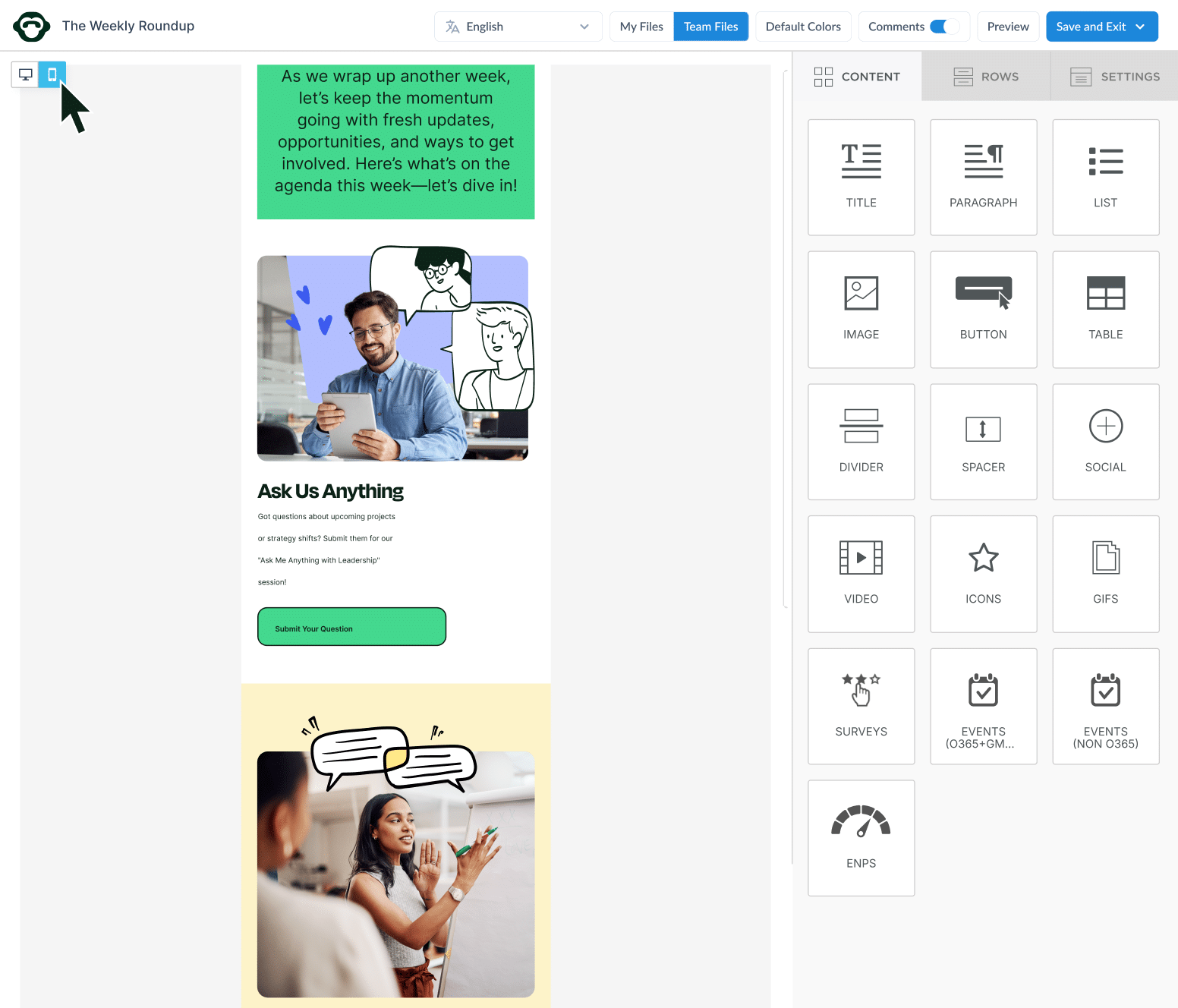
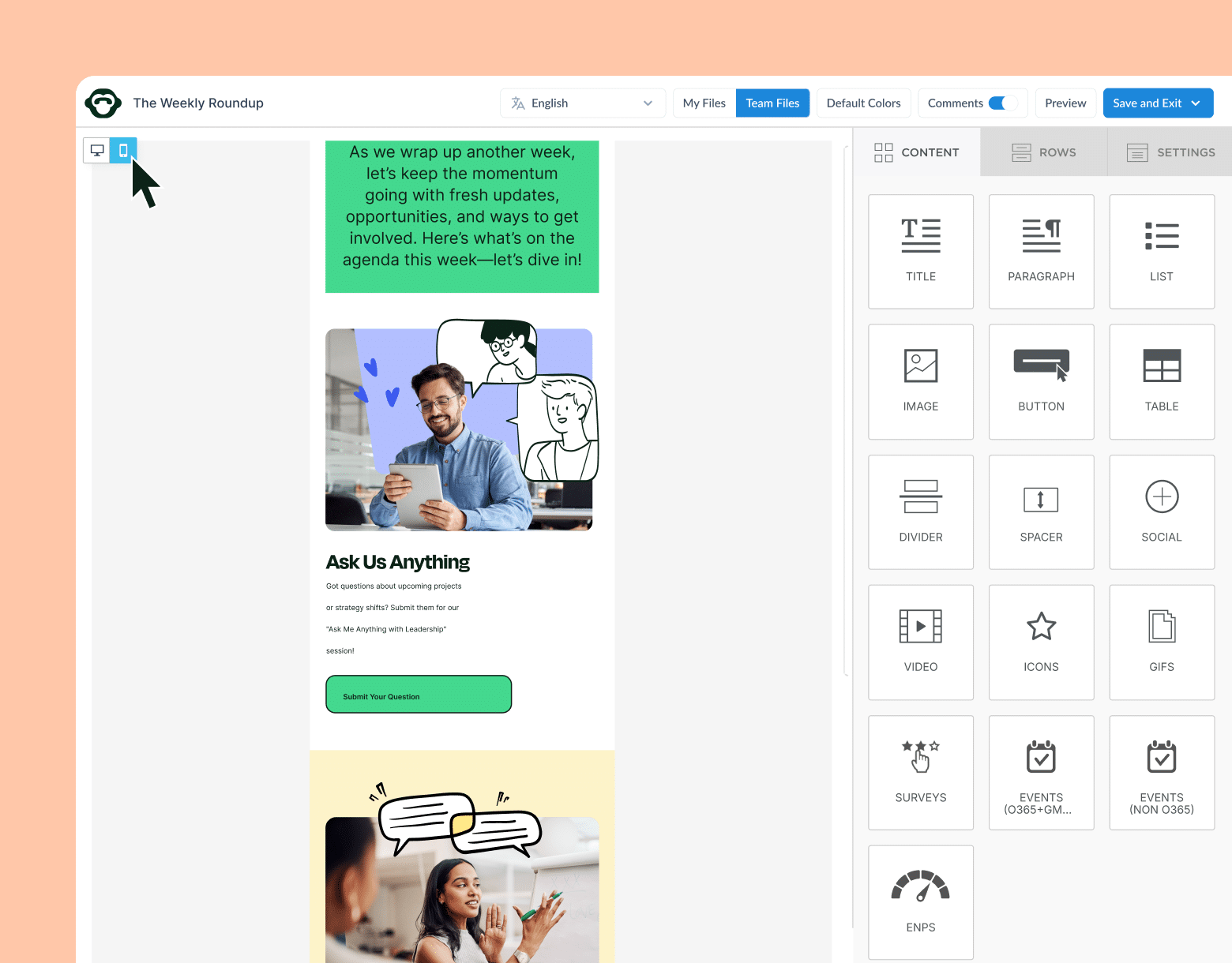
Step 1 — Define Campaign Goals Aligned with Business Objectives
Effective internal email communications start with clarity and intended outcomes in mind. Before jumping into what you’re going to say (or how), you must understand what you are trying to achieve and why. Anchoring internal communications in tangible business objectives helps ensure that every messaging sequence serves a measurable purpose.
Translate business goals into IC KPIs
To tie internal communications back to business goals, we must find communication metrics that are measurable and accurately reflect progress toward the goal. By converting broad business goals into clear internal communications KPIs, you create a shared language between leadership and communication teams, connecting engagement metrics to outcomes.
Before we get into some examples, here are a few best practices for translating business goals into IC KPIs effectively:
- Always start with the “why.” Identify what business leaders need to see (awareness, behavioral changes, mindset shifts, or some combination) and how communication can and will influence outcomes.
- Lean into both quantitative and qualitative measures. Internal email open rates demonstrate reach; feedback, sentiment, and manager conversations indicate resonance.
- Work with business partners to develop a shared understanding. Meet with leaders from relevant departments (e.g., HR, IT, operations) to understand success metrics from their perspective and identify which communication KPIs will resonate best with them.
- Consider short and long-term impact. A campaign may have both immediate engagement goals (e.g., training completions) and longer-term impact goals (e.g., adoption, retention, or cultural change).
Examples: digital adoption, DEI, retention, safety
Let’s take a closer look at some examples of how to translate organizational objectives into measurable communication outcomes in practice:
| Business Goal | Internal Communication Objectives | Example KPIs |
| Digital adoption of new automated tools | Increase awareness, understanding, and use of the tool | Open rates, clickthrough rates, training completion rates, active users, and pulse surveys |
| Advance DEI initiatives | Increase knowledge of and participation rates in DEI programs | Event registration, DEI learning completion rates, and participation feedback |
| Improve employee retention (in partnership with HR and other teams) | Reiterate and strengthen employees’ connection to the organization’s purpose and mission | Sentiment, employee engagement survey feedback, and pulse surveys |
| Strengthen safety practices across the organization | Reinforce safety protocols and reward compliance behaviors | Open rates, incident reduction trends, safety quiz/polls performance, and pulse surveys |
By mapping KPIs this way, internal communicators can quantify their impact. While the examples above outline quantitative measures, don’t forget that qualitative data, including anecdotal feedback, observable behavior, and informal conversations, adds richness and context to the numbers.
🐒 PRO TIP: When leadership sets quarterly or annual goals, proactively meet with business partners to identify areas where communication can enable success. Add any set dates and timelines to your comms editorial calendar for planning purposes.
Unlock Internal Comms Superpowers
Discover why 10,000+ rely on us. See the internal email and employee newsletter platform in action.
Book demo

Step 2 — Build Campaign Structure
Structure gives campaigns shape, outlining who receives what, when, and through which channels. An effective internal communications campaign reflects a coordinated experience that guides employees through messaging relevant to them, presented sequentially across multiple formats.
Audience segmentation + targeting
Not every employee needs the same message, and certainly not in the same way. Audience segmentation drives engagement and prevents fatigue by sending employees messages that are relevant to their specific roles and work. Additionally, personalized, targeted communication tells employees that their organization values their time by sending them what’s most essential and meaningful.
🐒 PRO TIP: Tools like ContactMonkey make it easy for internal communicators to segment and target their readers by role, department, region, demographics, and more.
Sequencing and narrative arcs
Internal communication campaigns should tell a story and give employees a narrative arc to follow throughout the email journey. Effective sequencing allows employees time to understand, internalize, and act on the information provided, as each email builds upon the one before it.
Read more: Learn how you can transition your internal email strategy from one-off sends to campaign thinking.
Channels beyond email (intranet, Slack, etc.)
You can amplify the impact of internal emails by using complementary channels strategically. Integrated campaigns meet employees where they already are — whether that’s the intranet, Slack, or digital signage at the office.
For example, you might extend your email campaign by:
- Posting deeper content that employees may need frequent access to (FAQs, video tutorials, event signups) on your intranet or other digital platforms
- Sharing short reminders, polls, and brief updates to reinforce key messages in Slack or Teams
- Aligning leadership updates during town halls and manager meetings with campaign themes for consistency
- Using on-site screens, posters, and physical handouts to reinforce messages to frontline workers or hybrid employees
Watch ContactMonkey LIVE in action
Join live demo

Step 3 — Execute with Templates and Personalization
Consistent design and personalized delivery are what turn a well-planned internal communication strategy into an employee experience that feels seamless and intentional. Internal communication email templates and dynamic email personalization make this possible.
Use internal email templates
Templates save time, maintain design consistency, and help employees instantly recognize official internal communications. A solid internal email template library enables communicators to focus on achieving the goals of the IC campaign, rather than spending time designing each email or series from scratch.
Here’s how email templates directly support campaigns that support organizational goals:
- Consistency (recognizable templates) builds credibility. Well-crafted email templates help employees quickly identify and recognize official updates tied to strategic initiatives. Use the same branding, design, and vocabulary (i.e., don’t phrase goal language differently each time) for emails that are part of a connected series.
- Structure supports clarity. Following a similar layout, customized to the specific content, helps employees find the most critical information they need. For example, if you share a summary of key messages at the top of an email, keep that section in the same place each time to prevent confusion.
- Fewer internal email design choices = more time for strategic messaging. Communicators should focus on storytelling and alignment with organizational goals rather than creating an internal email format from scratch each time.
Dynamic personalization by role/location
When internal email campaigns tailor messaging to specific audiences, they directly support the behaviors and outcomes tied to business priorities. Personalization helps employees understand why a message matters to them and what the organization expects them to do with it, allowing them to see themselves within the context of the organizational goals.
Personalization by role, location, or other segment is an excellent way to demonstrate how internal comms contributes to driving organizational goals, as relevance supports resonance and drives action. Role-specific instructions and expectations emphasize the importance each individual plays in contributing to organizational goals.
Internal email examples: onboarding, recognition, change adoption
Let’s take a closer look at some internal communication email examples that support organizational goals.
| Business Goal | Internal Communication Objectives | Email Sequence Ideas (with Personalization) | Example KPIs |
| Increase retention rates with an effective onboarding practice | Support retention increase (in partnership with HR and other teams) | Welcome email from senior leadership Welcome email from manager + first day essentials (department-specific tools, links, need to knows)Expectations and key training overview from their manager or onboarding buddyCulture and events overview + how to get involved1-month check-in and support with a brief survey | Open rates, clickthrough rates, read time, training completion rates, event attendance and participation, survey completion |
| Strengthen company culture and improve employee engagement scores | Support culture and engagement (in partnership with HR and other teams) | Introduction to the recognition campaign and why senior leaders have chosen to focus on recognition this quarter/yearRollout recognition nomination program; segment emails by role (managers, individual contributors) Spotlight with tailored nominations by location, role, or team Personalized email to employees who won an award based on nominationsWrap-up message from the leadership team | Open rates, clickthrough rates, engagement by segment, nomination/participation metrics, pulse surveys |
| Digital transformation and increased efficiency goals | Support the adoption of a new AI tool and influence usage | Heads-up email from senior leaders to managers about AI tool rollout with FAQ and talking pointsRequired training for managers before the announcement Company-wide announcement sharing what’s changing and whyRole-based follow-up with what employees need to do and by when (including training information)Role-based/interaction reminders leading up to deadlinesCelebration email highlighting training completion, productivity improvements | Open rates, clickthrough rates, read time, training completion rates, tool login metrics, pulse surveys |
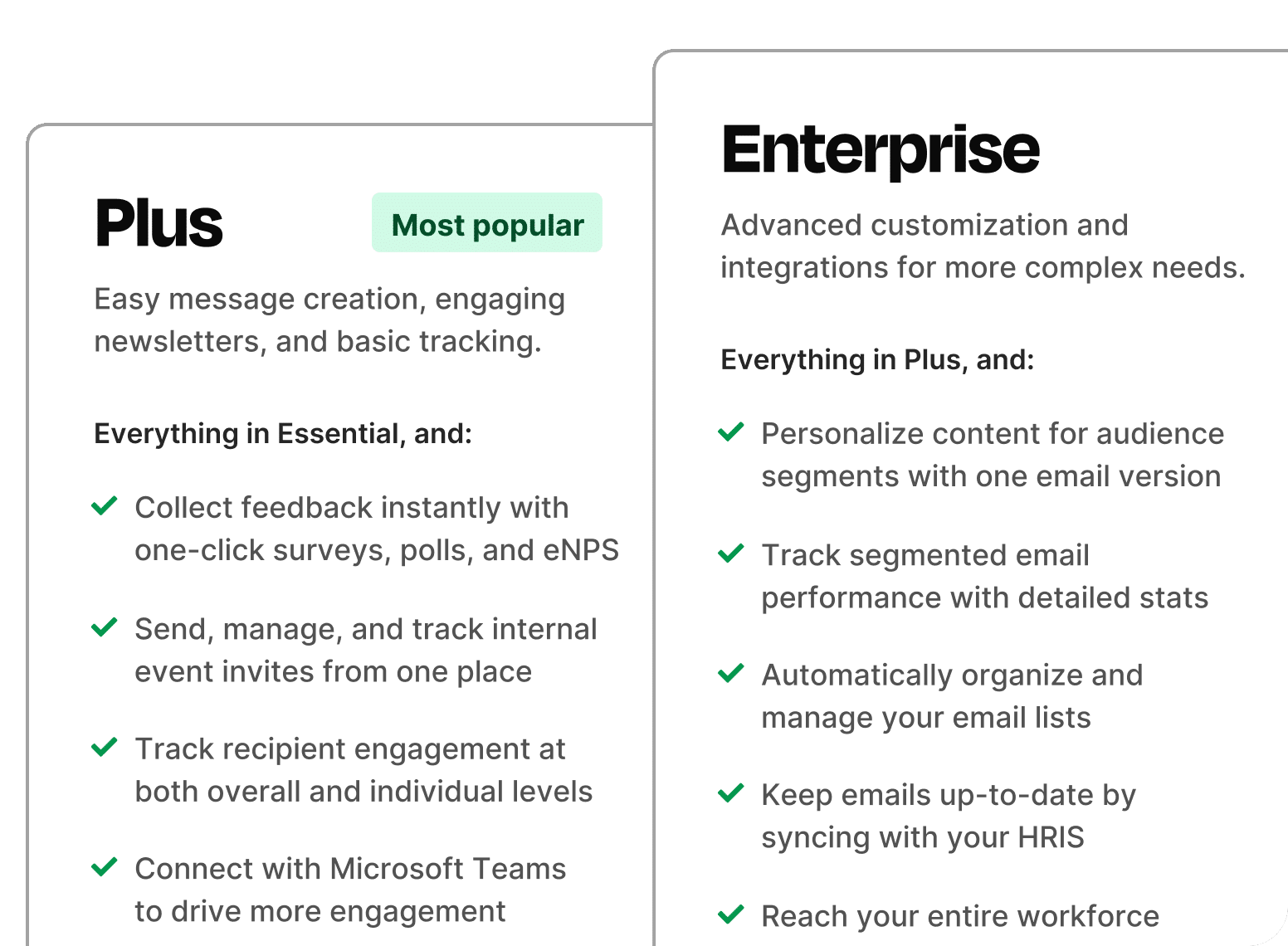
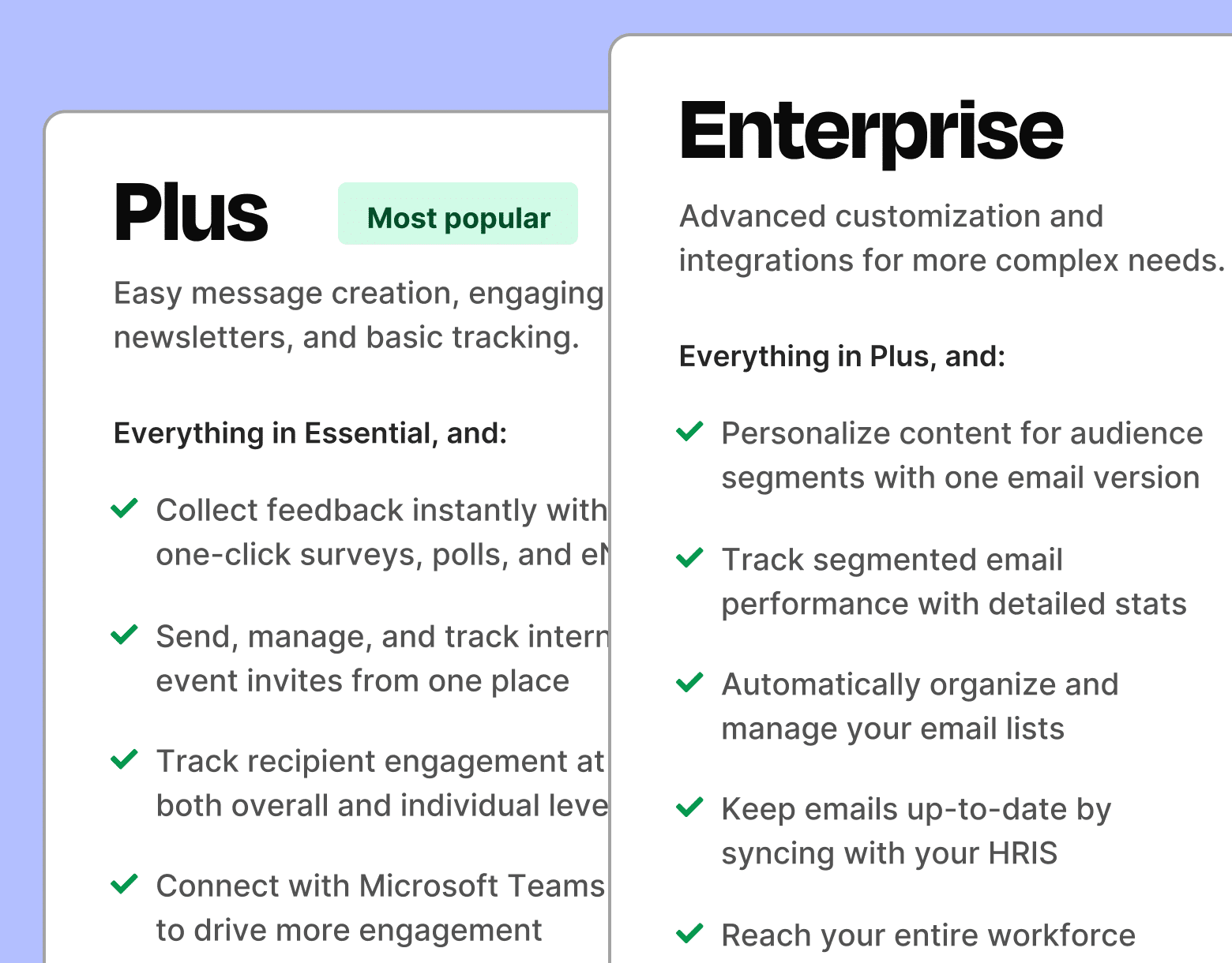
Step 4 — Measure Campaign Effectiveness
Internal communication campaigns only move the business forward if you can demonstrate how communication drives the behaviors and outcomes the organization cares about. Business leaders want to see how internal email campaigns are driving business impact, which requires performance measurement.
Internal email analytics + benchmarks
Internal email analytics provide visibility into whether messages are even reaching employees. Some metrics, such as clickthrough rates and read time, take traditional reach a step further and can help us understand whether employees are taking specific actions. This can help indicate trends in behavioral change. For example, if employees don’t click a link to a training video that outlines a new workflow, they’re less likely to adopt the change, as they are unaware of it.
🐒 PRO TIP: Knowing industry internal email benchmarks can help you understand how your organization performs compared to others sending similar communications. ContactMonkey’s 2025 Internal Email Benchmark Report reveals clear patterns in email engagement across industries and organization sizes.
Key metrics: open rate, CTR, read time, survey results
The following four metrics are crucial to track because they collectively demonstrate how an internal email campaign can contribute to improved organizational outcomes. These metrics work similarly to a funnel, each demonstrating a different stage along the way:
- Open rate: While an open doesn’t guarantee reading, open rates help internal comms teams understand which topics, segments, or subject lines garner attention. Reach is the first step in effective messaging, driving organizational goals.
- Clickthrough rate (CTR): A strong CTR can directly reflect movement toward organizational goals. CTRs can inform teams that employees are not only seeing the message, but also taking action.
- Read time: Like CTR, read time indicates whether employees are engaging with the content of an email and spending sufficient time to understand expectations, changes, or critical updates.
- Survey results: Pulse surveys and other feedback forms reveal whether employees feel informed and supported, as well as whether they receive the right information at the right time. Understanding sentiment and perceived clarity are crucial components for demonstrating the impact of internal communications on business outcomes.
This layered approach provides IC teams with credible evidence of their role in driving outcomes.
Campaign optimization (A/B tests, CTA performance)
By testing and refining messages over time, IC teams can directly influence whether employees complete the behaviors that support organizational goals. Internal email campaign optimization involves learning how to improve campaign performance.
A/B testing enables internal communicators to identify which version of a message is more effective in driving employee action. Test subject lines, CTA phrasing, message length, or even email sequence order (just don’t change all of these at once!).
Monitoring CTA performance is essential for ensuring employees move beyond the initial step of opening emails, which is crucial for progressing beyond merely pushing status updates and driving tangible business results.
Tools to Enable Goal-Driven Campaigns
Knowing how to enable goal-driven campaigns is only half the battle. Having the right internal email communication tools in place to support planning, execution, and internal email measurement makes all the difference.
Internal comms email platforms for campaign planning
Remember how we mentioned proactively meeting with business partners during goal-planning cycles to identify areas where communication can enable success?
Internal comms email software like ContactMonkey is perfect for internal communication campaign planning because you can improve planning with a built-in content calendar feature (get those goal-driven campaigns locked in early!). Not to mention, you can personalize better to reach employees at the right time (more on that next). Learn more on how to create your communications content calendar.
ContactMonkey features: segmentation, personalization, analytics
Deliver and measure your internal email campaigns with ContactMonkey’s suite of internal email features, including:
- Audience segmentation: Create highly relevant employee emails with custom segments and list management, plus audience segmentation analytics that help you see which departments, teams, or regions are engaging with your messages to identify gaps.
- Personalization: Tailor subject lines, images, dynamic content blocks, merge tags, and timezone-specific sending to ensure your internal communications reach the right audience with the right information at the right time.
- Analytics: ContactMonkey helps internal communicators prove value and drive action with real-time visibility into email metrics like open rates, CTR, location, device type, read time, and more. Plus, benchmark internal email performance for continuous improvement and build leadership-ready reports in minutes.
Drive Organizational Success with Effective Internal Communication Campaigns
When internal email campaigns intentionally align with business goals, communication stops being a support function and becomes a driver of measurable impact. ContactMonkey helps internal communicators become strategic partners with the data and analytics they need to prove their value. Unlock the insights you need to sharpen your internal comms strategy and drive real business outcomes. Book a free demo and see how ContactMonkey turns data into direction.